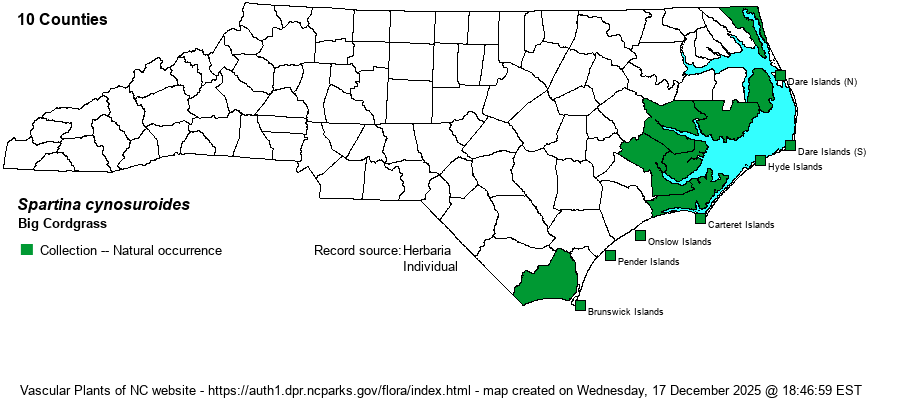| Author | (L.) Roth | |
| Distribution | Outer Banks, barrier islands, and outer Coastal Plain.
Maritime, MA to northern FL and eastern TX. | |
| Abundance | Uncommon to locally abundant; usually forms monospecific patches or strings along tidal channels. The NCNHP considers this as S5, but it is not overly common, at least as compared with the other two coastal members of the genus -- S. alterniflorus and S. patens -- each of which is certainly common and widespread and deserving of an S5 rank. The website editors do not recommend a rank of S4, but that may be a more truthful rank than S5. | |
| Habitat | Brackish and fresh tidal marshes, often on slight elevations or along tidal channels. Typically found closest to a channel, with other graminoids behind it -- such as Juncus roemerianus, Cladium jamaicense, and others. |
| Phenology | Flowering and fruiting June-September. | |
| Identification | This is by far our tallest member of the genus, the stems reportedly up 11 feet (FNA), but most often 5-8 feet tall in NC. The leaves usually grow 2-3 feet long and are long-tapered. Inflorescences are terminal and about a foot long, with many spreading to ascending branches. Its height carries it above other marsh plants except Common Reed (Phragmites australis). That alien species can grow with it and often out-competes it; they can be easily confused by inexperienced people, though Phragmites has a much bushier/denser inflorescence, darker green leaves, and leaves angling off the stem (as opposed to generally erect/ascending leaves in Big Cordgrass). | |
| Taxonomic Comments | | |
| Other Common Name(s) | Giant Cordgrass | |
| State Rank | S5 | |
| Global Rank | G5 | |
| State Status | | |
| US Status | | |
| USACE-agcp | OBL link |
| USACE-emp | OBL link |

